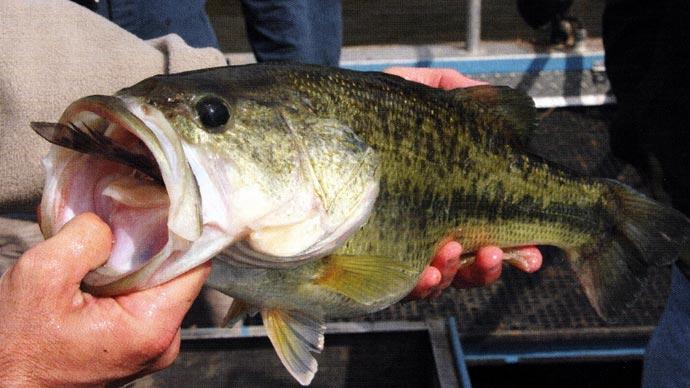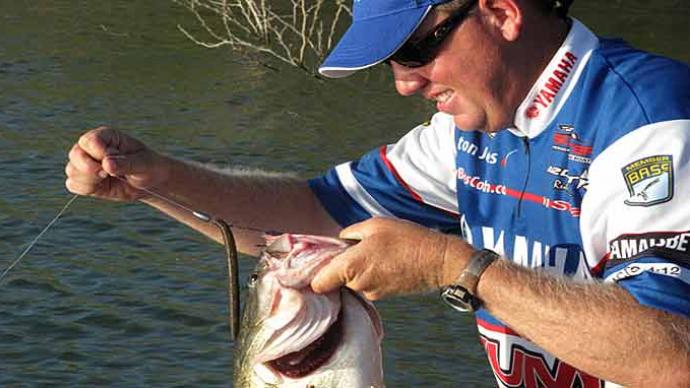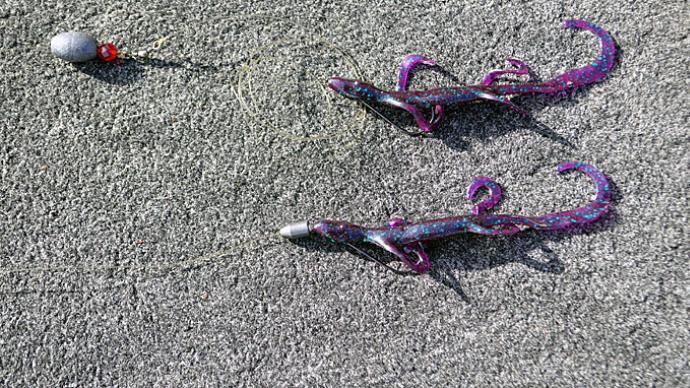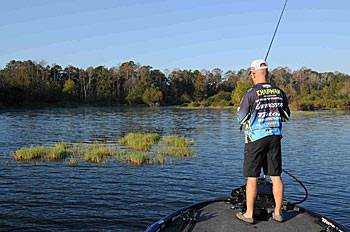
Any time a new soft plastic is introduced, it seems like a new rigging tactic accompanies the lure.
The latest rig for finesse soft plastics include the Neko and Ned rigs, which were preceded by the wacky and drop shot rigs. However, one old-fashioned rig works for almost all soft plastics on the market today.
Year in and year out, the Texas rig continues to be the best match for the gamut of soft plastic baits. “It’s simple, and it so resembles ultimately what bass eat day in and day out year after year,” says Bassmaster Elite Series pro Brent Chapman. “It is such a versatile way to fish as well. You can fish it in 6 feet of water or 60 feet of water.”
Chapman also favors the Texas rig because it creates a streamlined bait and makes it weedless. So he can present the lure into any bass hideout right in front of the fish’s face.
In addition to the lure, the Texas rig consists of three essential elements: a bullet-shaped sinker, a pegging device, and a hook. Chapman believes the hook is the critical component of the rig. “There is such a diversity in hooks now that they make a hook that will fit every type of plastic,” he says. “Then on top of that, the quality of how sharp hooks are and the strength of the hook helps for good hookups and getting fish out of places that we may not have been able to do 20 years ago.”
Chapman matches his hooks on the Texas rig with a Picasso Tungsten Worm Weight and an Eagle Claw Bobber Stop for pegging his weight. “I always peg everything I flip except a flipping tube,” Chapman says.
The Kansas pro discloses that he relies on a heavier weight than most anglers for his Texas-rigged soft plastics. “I like to get a fast fall out of the lures for the most part,” he says.
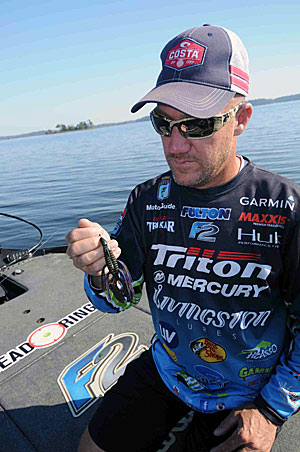
After slipping the rigging stop and sinker on his line to start his Texas rig, Chapman ties on his hook with a Palomar knot. “If you tie (the Palomar) correctly, it is one of the strongest knots out there,” Chapman says.
When attaching the soft plastic lure, insert about 1/4 inch of the hook point into the top of the bait. Then turn the hook and exit the lure at the side of the head. Slide the lure up the hook shaft and twist the lure around the shaft, so the hook's point faces the lure. Then insert the hook at a right angle into the lure and drive the hook point through the lure’s body. Complete the rig by pushing up on the lure to slip the hook point just underneath the plastic surface to make the bait weedless.
“The biggest key to Texas rigging is getting the bait to be straight because a straight bait looks more natural, and if you don’t get it straight, it tends to twist your line,” Chapman says.
Chapman’s top three soft plastics for Texas rigging are the 3-inch Tightlines UV Beaver, Tightlines UV-Enko, and a 4-inch flipping tube. The 3-inch Beaver is Chapman’s favorite for most of his Texas-rigged tactics. “I like that bait because I can punch it through mats or just pitch it around,” he says. “The 3-inch version is a little bit smaller than what most people fish, but it is a pretty compact bait, and I think it will get strikes when other baits won’t just because it is small.”
The four-time B.A.S.S. winner matches the Beaver with a Trokar TK130 Flippin Hook and a Picasso Tungsten Worm Weight ranging in sizes from 1/8- to 1 1/2 ounces depending on the situation. When flipping around shallow brush or docks, he relies on the 1/8-ounce weight but switches to the 1 1/2 –ounce sinker for punching thick grass mats.
The UV-Enko is a stickworm Chapman Texas rigs either weightless or with a sinker, sometimes as heavy as 1/2-ounce. “That is just another bait that catches fish all the time,” he says. The tournament veteran uses a 4/0 Trokar EWG hook for Texas rigging with the UV-Enko.
Missed hookups and lost fish have caused anglers to shy away from the flipping tube. Chapman was one of those anglers until he found the right hook for the job. “I kind of fell in love all over again with a tube when Trokar came out with their tube hook, which has a bait keeper up by the eye of the hook that holds the tube on really well,” he says.
“It also has a Kahle-shaped hook that is perfect for a tube.” Chapman impales the 4-inch flipping tube on a 6/0 Trokar Tube Hook and adds a Picasso Tungsten Worm Weight sinker varying in weight from 1/8 to 3/4 of an ounce.
Chapman’s Texas-rigging gear includes a 7 1/2-foot flipping stick and a high speed (7.1:1 or higher gear ratio) baitcast reel spooled with either Gamma Fluorocarbon or braid line. When Texas-rigging trick or finesse worms in open water, Chapman uses 12-pound fluorocarbon, but he upgrades to 25-pound fluorocarbon when flipping soft plastics into heavy cover. The Kansas angler relies on 50- or 60-pound braid for punching mats with his Texas-rigged baits.
BassResource may receive a portion of revenues if you make a purchase using a link above.


